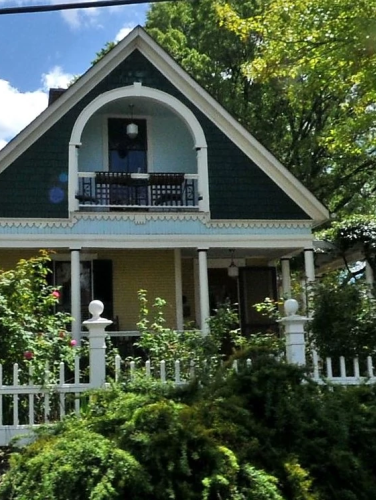
Helms-Bell House
(ca. 1899)
This unique early Dilworth home was originally located at the intersection of South Caldwell Street and Lexington Avenue.
2021 Euclid Ave, Charlotte, NC 28203
Built in 1899, the Helms-Bell House is one of the last surviving nineteenth-century houses in Dilworth, Charlotte’s first streetcar suburb. The Queen Anne Victorian style Helms-Bell House was originally located at the intersection of South Caldwell Street and Lexington Avenue but was moved in 1997 to Euclid Avenue to avoid demolition. It is the only survivor of the many turn-of-the-century residences that once lined the streets around that intersection.
Property Quick Links
The Helms-Bell House was built by Bessie Herring (1867-1908) in 1899. Born Bessie McReary in Vermont, she had married and was widowed from Jasper DeLaughter by the time she arrived in Charlotte in 1897 or 1898. With DeLaughter, she had two children: Ralph, who was born in 1887 in Georgia, and Lillian, who was born in 1890 in Alabama. Bessie and her two children first lived in Charlotte at 611 North Brevard Street. In April 1898, Bessie married a fifty-three-year-old traveling salesman named Marcus D. Herring (b. 1843). They lived in Bessie’s North Brevard Street house for another year.
In September 1899, Bessie purchased an empty lot in Charlotte’s new Dilworth suburb for $625. The lot fronted on South Caldwell Street and ran down Oak Street (now Lexington Avenue). Construction began promptly the following month. The Herrings remained in the house for some four years before moving to nearby East Boulevard, but kept the house as a rental property. A succession of tenants resided in the Helms-Bell House until the property was sold in 1918 to Taylor Edward Helms (1885-1971) and his wife Ray Elizabeth Helms (1891-1979), who lived there until 1943. Taylor was an optician who worked for the Pruett-Southerland Company and Charlotte Optical Company before founding the Southerland-Helms Optical Company in the 1920s. He and Ray raised two sons and a daughter in the Helms-Bell House. From 1943 through the mid-1990s, the residence was the home of Miss Ethel Bell. An accountant by profession, Ethel lived in the house with her widowed mother Addie V. Bell (1901-1966).
The most notable exterior feature of the Helms-Bell House is its recessed balcony in the front gable, an unusual element in Charlotte’s built environment. This house’s design has been attributed to Charles Christian Hook (1870-1938), one of Charlotte's first professional architects. The recessed balcony is similar to three other homes with such balconies known to have been designed around the turn of the century by his firm Hook and Sawyer, but the Helms-Bell House is the only one of those houses to survive. Hook was the first professional architect to live in Charlotte. After moving to Charlotte in 1891 to teach mechanical drawing in the local schools, he soon became the city’s first fulltime professional architect. Hook designed some 800 to 1,000 homes and buildings across the Carolinas, including Charlotte’s U.S. Post Office and Courthouse, Charlotte City Hall, the Carolina Theater, three local fire stations, and several buildings on college campuses across North Carolina (including the Chapel Hill and Greensboro campuses of the University of North Carolina, Davidson College, and N.C. State, Duke, and Queens Universities). Hook is credited with introducing the Colonial Revival architectural style into Charlotte’s built environment.

